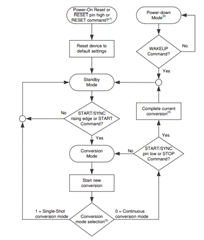Hello everyone,
me and my team have been working on a design incroporating the mentioned chip. After completion of the desing phase of this project, we discovered in the datasheet the following statement:
Tie the START/SYNC pin low when the device is controlled through the START and STOP commands. The START command is not decoded if the START/SYNC pin is high.
We sadly missed the statement that the Pin has to be tied to GND when using SPI commands only and therefore left the pin floating. With all of our 4 Prototype iterations we never encountered any issues, which is why we never noticed until now.
We are now in the QC of the series production units and are facing the issue, that some ADCs do not start reading any values or transmitting them over SPI after first bootup.
It seemed like the design flaw stated above would most certainly be the cause of this problem, which is why we ran some tests with the pin actively pulled high to reproduce this randomly appearing behavior. Contrary to our expectations, the conversion could successfully be started several times after bootup with the START/SYNC pin directly tied to the 3V3 (IOVDD) rail. This, to my understanding is contradictory to the information stated in the datasheet where it is stated that The START command is not decoded if the START/SYNC pin is high. I would kindly ask you to clarify how this could be possible? Am I missing something here or is the statement from the datasheet incorrect?
In addition to that, there is a flowchart showing the operating Modes of the ADC on page:

This suggests, that the START/SYNC- pin has to be actively pulled up again after starting the continuous conversion (where it has to be low for the start command to be registered). Otherwise it would "exit" the continuous conversion loop and to back to standby mode. I cannot believe this is how it is intended, because that would make the option to use only the SPI commands pointless, as you would have to actively control the START/SYNC pin anyways. Can you please clarify this too?
We have the option to manually solder the START/SYNC pin to a close by ground copper pour, but only want to do so, if we know that this solves our issues of temporarily not receiving any data from the adc, as would involve quite a bit of rework as you may understand. Therefore we have to be really certain, why I am seeking help in this forum.
Any help would be very much appreciated.
Thank you,
David

